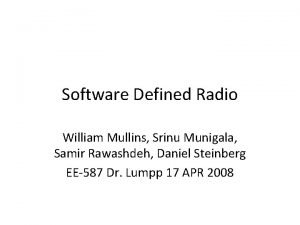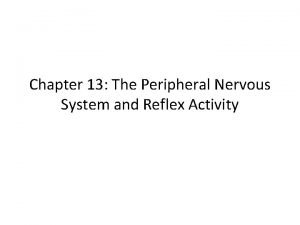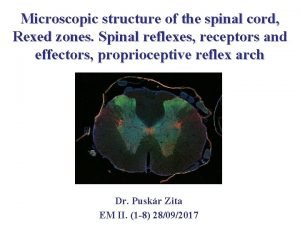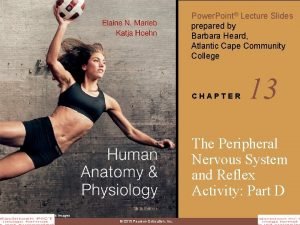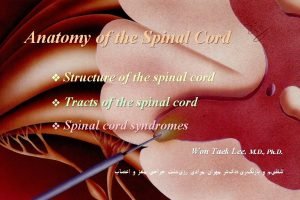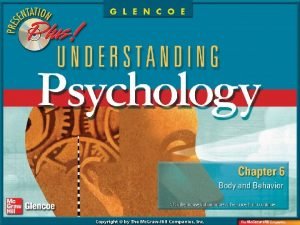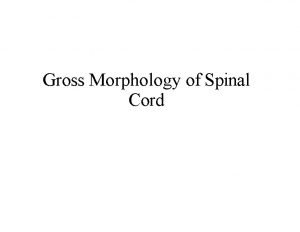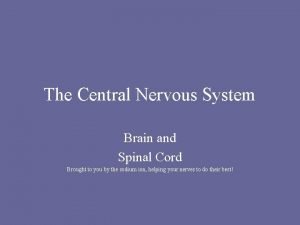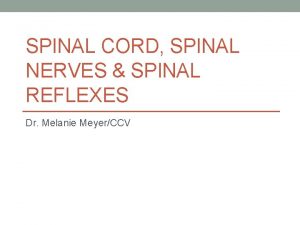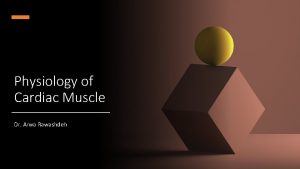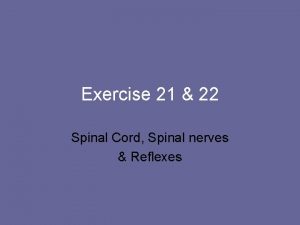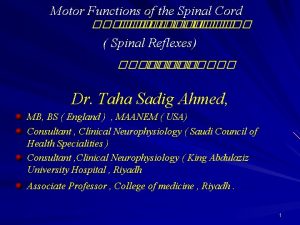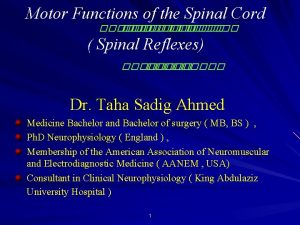Spinal cord reflexes Dr Arwa Rawashdeh Muscle spindle













- Slides: 13

Spinal cord reflexes Dr. Arwa Rawashdeh

Muscle spindle Stretch reflex Objectives Golgi tendon organ Type of reflexes ( monosynaptic, polysynaptic)

Muscle spindle Two types of fibers you must differentiate between in the skeletal muscle q Extrafusal muscle fibers ( attach to tendons so whenever the extrafusal muscle contract they pull on the tendon and pull on the bone and that going to generate movement) q Inside there is a connective tissue capsule encases these fiber inside and called intrafusal muscle fibers q not really connecting tendons these are what called proprioceptors (tell you the position of your muscles, joint……. In three-dimensional space allows you basically to close my eyes and able to know where my hand is extended or flexed Bunch of intrafusal muscle (spindle muscle)

If we want to be specific for intrafusal fibers the type of sensation Ø they are going to pick up is the length ( the degree of stretch) Ø and the velocity ( the speed at which is being stretched) Two types of intrafusal muscle fibers v Nuclear bag fibers ( dynamic and static) v Nuclear chain fibers Intrafusal muscle

The stretch reflex (myotatic reflex) The stretch reflex depends on the structure of intrafusal fibers So, we are going to dig in the structure of these fibers Nuclear bag fiber; is a kind of nucleic centrally located in the bulbous portion and sensitive to length and velocity Nuclear chain fibers; is a kind of nuclei centrally arranged in a linear or chain fashion and is sensitive to length Type 1 a fibers ( annulo spiral ending ) in both Nuclear bag fibers and nuclear chain fibers Type II fibers (flower spray endings) primarily found on nuclear chain

Deep tendon reflex and neuromuscular junction If we want to zoom in the type 1 a fiber and look at microscopely how the contraction occurs As you stretched stimulate specific channels on sensory neuron called mechanically gated ion channels and sodium start to flow in hits the resting membrane to threshold ; once it hits the threshold it opens anther channel called voltage gated channels again the sodium would flow in dramatically and generate action potential At the polar end you have gamma fiber release Ach and stretch the fiber When ever it contracts at the end it stretches the fiber activate the sensory fibers

Clinical application of deep tendon reflex Deep tendon reflex involve spindle muscle not Golgi tendon Put all the things in practice You are going to do patellar reflex Tap on patellar reflex stretch the quadriceps muscles 1. Type 1 a and type II is going to pick the sensation down to your dorsal ganglia and synapses directly onto a motor neuron and going out into the muscle and cause the muscle to contract ; one sensory neuron led to one motor neuron that is called monosynaptic reflex or ipsilateral monosynaptic reflex occurring at the same side When even you tap on the tendon you stretch the muscle, but what is the main job of these spindle muscle / the big job is to prevent over stretching of the muscle by shortening by contracting 2. . Type 1 a and type II is going to pick the sensation down to your dorsal ganglia and synapses to interneuron this would inhibit the motor neuron and not sending it to skeletal muscle and inhibit the antagonistic muscle or hamstring muscle, so they relax And this is called reciprocal inhibition The motor neuron we are talking about is alpha motor neuron that contract the extrafusal fiber muscle and inhibit the antagonistic muscle

Continued clinical application The same thing is happening to gamma neuron (intrafusal muscle) This is called alpha and gamma co activation The other thing I would like to add because it is clinically relevant is ; you have tracks here located in the lateral white column and called corticospinal tract these contains upper motor neuron synapses and modulate the activity of these gamma motor neurons But why is this important? ? If you have a lesion that damage the spinal cord neuron this will lead to gamma motor neuron activation because it modulate or inhibit the gamma naturally and that causes the muscle to have a lot of tone can lead to hypertonia or spasticity

Alpha and Gamma co activation If you stretch the muscle The Extra and intrafusal muscle stretched activate sensory fiber If we only contract the extrafusal muscle the intrafusal is slack means very lose not able to open mechanical channel and generate action potential How to combat that ? Extrafusal contract they shorten the muscle by alpha Intrafusal contract they length and stretch the muscle by gamma At the same time

Golgi tendon organ Inside the tendon we have ( interconnecting rope between the muscle and bone) Collagen fibrils Golgi tendon organs Sensory fibrils Type 1 b Collagen tendon organs contains proprioceptors that sense the tension in the tendon; that develops because of muscle contraction preventing tendon avulsion Activating type 1 b fiber generate action potential and send that information to CNS All proprioceptors in general tell us the position of the ligament, tendon in three-dimensional space

Inverse Myotatic reflex Type 1 b fibers Go to the dorsal root ganglion moves into posterior gray horn and bifurcate into on two different types of interneurons If your biceps muscle is contracting so much that is at risk of pulling the tendon off the bone do you want this muscle to keep contracting? If it does it is going to cause so much tension to develop that eventually that tendon is going to rip right off; so, the inhibitory interneuron is going to take the signals ( by neurotransmitter called glycine; hyperpolarize the cell) via alpha motor neuron to inhibit the contracting muscle and causing that muscle to relax and stimulate the antagonistic by stimulating interneuron ( glutamate) Called reciprocal activation compared to reciprocal inhibition ( muscle spindle) Autogenic inhibition

Polysynaptic reflexes

Summary
 Inferior gluteal nerve
Inferior gluteal nerve Spinal nerves labeled
Spinal nerves labeled The spinal nerves
The spinal nerves Median nerve innervates
Median nerve innervates Samir rawashdeh
Samir rawashdeh Arwa-028
Arwa-028 Muscle spindle
Muscle spindle Tendon histology
Tendon histology Muscle spindle
Muscle spindle Spinomedullary junction
Spinomedullary junction Spinal cord injury shoulder exercises
Spinal cord injury shoulder exercises Nerves branching beyond the spinal cord into the body
Nerves branching beyond the spinal cord into the body Spinal cord function
Spinal cord function Spinal cord structures
Spinal cord structures




